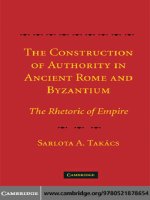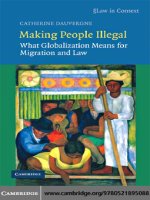cambridge university press byzantium between the ottomans and the latins politics and society in the late empire apr 2009 kho tài liệu bách khoa
Bạn đang xem bản rút gọn của tài liệu. Xem và tải ngay bản đầy đủ của tài liệu tại đây (2.15 MB, 374 trang )
This page intentionally left blank
BYZANTIUM BETWEEN THE OTTOMANS
AND THE LATINS
This is the first detailed analysis of Byzantine political attitudes
towards the Ottomans and western Europeans during the critical last
century of Byzantium. The book covers three major regions of the
Byzantine Empire – Thessalonike, Constantinople, and the Morea –
where the political orientations of aristocrats, merchants, the urban
populace, peasants, and members of ecclesiastical and monastic circles are examined against the background of social and economic
conditions. Through its particular focus on the political and religious
dispositions of individuals, families, and social groups, the book offers
an original view of late Byzantine politics and society which is not
found in conventional narratives. Drawing on a wide range of Byzantine, western, and Ottoman sources, it authoritatively illustrates how
late Byzantium was drawn into an Ottoman system in spite of the
westward-looking orientation of the majority of its ruling elite.
nevra necipo g˘ lu is Professor of History at Bo˘gazic¸i University,
Istanbul. She has written numerous journal articles on late Byzantine
society, economy, and politics, and edited Byzantine Constantinople:
Monuments, Topography and Everyday Life (2001).
BYZANTIUM BETWEEN THE
OTTOMANS AND THE LATINS
Politics and Society in the Late Empire
˘
NEVRA NECIPO GLU
CAMBRIDGE UNIVERSITY PRESS
Cambridge, New York, Melbourne, Madrid, Cape Town, Singapore, São Paulo
Cambridge University Press
The Edinburgh Building, Cambridge CB2 8RU, UK
Published in the United States of America by Cambridge University Press, New York
www.cambridge.org
Information on this title: www.cambridge.org/9780521877381
© Nevra Necipoglu 2009
This publication is in copyright. Subject to statutory exception and to the
provision of relevant collective licensing agreements, no reproduction of any part
may take place without the written permission of Cambridge University Press.
First published in print format 2009
ISBN-13
978-0-511-51807-2
eBook (NetLibrary)
ISBN-13
978-0-521-87738-1
hardback
Cambridge University Press has no responsibility for the persistence or accuracy
of urls for external or third-party internet websites referred to in this publication,
and does not guarantee that any content on such websites is, or will remain,
accurate or appropriate.
¨ u and Hikmet Necipo˘glu,
To my parents, Ulk¨
and
in loving memory of Angeliki Laiou
Contents
List of maps
Acknowledgements
Note on transliteration
List of abbreviations
page ix
xi
xiii
xiv
part i introduction and political setting
1
The topic and the sources
3
2
The shrinking empire and the Byzantine dilemma between
East and West after the Fourth Crusade
18
part ii thessalonike
3
Social organization, historical developments, and political
attitudes in Thessalonike: an overview (1382–1430)
41
4
Byzantine Thessalonike (1382–1387 and 1403–1423)
56
5
Thessalonike under foreign rule
84
part iii constantinople
6 The Byzantine court and the Ottomans: conflict and
accommodation
7
The first challenge: Bayezid I’s siege of Constantinople
(1394–1402)
8 From recovery to subjugation: the last fifty years of
Byzantine rule in Constantinople (1403–1453)
vii
119
149
184
Contents
viii
part iv the despotate of the morea
9
10
The early years of Palaiologan rule in the Morea (1382–1407)
235
The final years of the Byzantine Morea (1407–1460)
259
Conclusion
285
Appendix I: Archontes of Thessalonike (fourteenth–fifteenth centuries)
Appendix II: “Nobles” and “small nobles” of Thessalonike (1425)
Appendix III: Constantinopolitan merchants in Badoer’s
account book (1436–1440)
Appendix IV: Members of the Senate of Constantinople cited in the
synodal tome of August 1409
Appendix V: Some Greek refugees in Italian territories after 1453
Bibliography
Index
293
297
299
304
305
307
339
Maps
1. The Byzantine world in the fourteenth–fifteenth centuries
2. Byzantium and its neighbors, c. 1350
3. Byzantium and its neighbors after 1402
ix
page xviii
xx
xxi
Acknowledgements
This book grew out of my doctoral dissertation submitted to the History
Department of Harvard University in 1990. In the course both of the
evolution of the dissertation and of its transformation into a book, I
benefited from the guidance and support of numerous individuals and
institutions.
My deepest gratitude goes to Angeliki E. Laiou – an exemplary teacher,
thesis supervisor, colleague, and friend – who has been an endless source
of inspiration and wisdom through all these years. Without her encouragement and continued interest, this project might have taken even longer to
complete the transformation from thesis to book. The late Nicolas Oikonomid`es deserves particular mention for the many invaluable suggestions as
well as the enthusiastic support he provided up until his much regretted
ˇ cenko, who introduced me to the intricadeath in May 2000. To Ihor Sevˇ
cies and mysteries of Byzantine Greek, I extend my very special thanks for
his instruction, encouragement, and genuine interest in my work. Along
the way, I was fortunate to have stimulating discussions with and to receive
invaluable guidance, comments, references, offprints, or, during moments
of despair, much needed personal support and encouragement from a number of friends and colleagues, among whom I warmly acknowledge Michel
Balard, Ir`ene Beldiceanu-Steinherr, Faruk Birtek, the late Robert Browning, Melek Delilbas¸ı, Marie Theres F¨ogen, Thierry Ganchou, Selahattin
Hakman, Halil ˙Inalcık, Mahnaz Ispahani, David Jacoby, Cemal Kafadar,
Michel Kaplan, the late Alexander Kazhdan, Klaus-Peter Matschke, C´ecile
¨
Morrisson, G¨ulru Necipo˘glu, Soli Ozel,
Yes¸im Sayar, Kostis Smyrlis, AliceMary Talbot, Bet¨ul Tanbay, and Elizabeth Zachariadou. I am also grateful
to my colleagues at the History Department of Bo˘gazic¸i University, as well
as to my graduate students, who contributed to the completion of this
book through their moral support and enthusiasm in things Byzantine.
Furthermore, I wish to thank Elif C
¸ akın for her help in drawing the maps.
Finally, I would like to express my lifelong indebtedness to my parents
xi
xii
Acknowledgements
¨ u and Hikmet Necipo˘glu, for they were the ones who sparked both my
Ulk¨
general interest in history and my particular curiosity for the Byzantine past
of Istanbul on the occasion of our memorable visits to the Hagia Sophia
and other historic sites of the city in my childhood days.
Material support for this work was provided by generous grants from
a number of institutions. The Department of History and the Graduate School of Arts and Sciences of Harvard University supplied grants
throughout the writing of the dissertation. A Junior Fellowship at Dumbarton Oaks during 1986–7 afforded me the first opportunity to engage in
full-time research directed towards my topic. Much subsequent groundwork was laid once again at the same institution, where I spent the academic
year 1993–4 as a Fellow in Byzantine Studies. I hereby would like to extend
my thanks to all the members of the Dumbarton Oaks community, in
particular to Irene Vaslef and Mark Zapatka of the Byzantine Library,
who created a warm and friendly atmosphere that was most conducive to
productive work on both occasions. Owing to the initiative and encouragement of Nus¸in Asgari, I also spent a profitable month at Oxford as a
Martin Harrison Memorial Fellow in the summer of 1995, which enabled
me not only to utilize the abundant resources of the Bodleian Library, but
to enjoy as well the hospitality of Mrs. Elizabeth Harrison. Further work
on the book was undertaken during leave as a visiting professor at the
University of Paris I in the spring of 2002. I am grateful to Michel Kaplan
for his kind invitation and to the staff members of the Byzantine libraries
of the Sorbonne, Coll`ege de France, and Centre National de la Recherche
Scientifique for their assistance.
Some of the material in this book has been discussed or has appeared
in different versions in the following publications: “Ottoman merchants
in Constantinople during the first half of the fifteenth century,” Byzantine and Modern Greek Studies 16 (1992), 158–69; “Economic conditions in
Constantinople during the siege of Bayezid I (1394–1402),” in Constantinople and its Hinterland, ed. C. Mango and G. Dagron (Aldershot, 1995),
pp. 157–67; “Constantinopolitan merchants and the question of their attitudes towards Italians and Ottomans in the late Palaiologan period,” in
Polypleuros nous: Miscellanea f¨ur Peter Schreiner zu seinem 60. Geburtstag,
ed. C. Scholz and G. Makris (Munich and Leipzig, 2000), pp. 251–63; “The
aristocracy in late Byzantine Thessalonike: a case study of the city’s
archontes (late 14th and early 15th centuries),” Dumbarton Oaks Papers 57
(2003), 133–51; “Social and economic conditions in Constantinople during
Mehmed II’s siege,” in 1453. H lwsh thv KwnstantinoÅpolhv
kai h metbash ap» touv mesaiwnikoÅv stouv neÛterouv cr»nouv,
ed. T. Kioussopoulou (Iraklion, 2005), pp. 75–86.
Note on transliteration
In general, I have employed a Greek transliteration of Byzantine proper
names and technical terms. However, some common first names have been
rendered in their modern English form: for example, John, not Ioannes,
and Constantine, not Konstantinos. By the same principle, for well-known
place names I have generally preferred the use of conventional modern
English spelling: for example, Constantinople, Athens, and Coron. For
proper names and technical vocabulary pertaining to the Ottomans, on
the other hand, modern Turkish orthography has been used.
xiii
Abbreviations
Anagnostes–Tsaras
As¸ikpas¸azade–Atsiz
As¸ikpas¸azade–Giese
ASLSP
B
Badoer
Badoer: Indici
BF
BMFD
BMGS
BS
ByzSt
BZ
Chalkok.–Dark´o
Chilandar
ìIwnnou ìAnagnÛstou Dighsiv perª t¦v
teleuta©av lÛsewv t¦v Qessalon©khv, ed.
J. Tsaras (Thessalonike, 1958)
ˆ Osmˆan, in Osmanli Tarihleri, ed.
Tevˆarˆıh-i Al-i
N. Atsiz, vol. i (Istanbul, 1949)
¯¸ik.pas¸az¯ade,
Die altosmanische Chronik des ‘As
ed. F. Giese (Leipzig, 1929)
Atti della Societ`a Ligure di Storia Patria
Byzantion
Il libro dei conti di Giacomo Badoer
(Costantinopoli 1436–1440), ed. V. Dorini and
T. Bertel`e (Rome, 1956)
Il libro dei conti di Giacomo Badoer
(Costantinopoli 1436–1440). Complemento e
indici, a cura di G. Bertel`e (Padua, 2002)
Byzantinische Forschungen
Byzantine Monastic Foundation Documents,
ed. J. Thomas and A. C. Hero, 5 vols.
(Washington, DC, 2000)
Byzantine and Modern Greek Studies
Byzantinoslavica
´
Byzantine Studies/Etudes
Byzantines
Byzantinische Zeitschrift
Laonici Chalcocandylae Historiarum
Demonstrationes, ed. E. Dark´o, 2 vols.
(Budapest, 1922–7)
Actes de Chilandar, vol. i: Des origines a` 1319,
ˇ
ed. M. Zivojinovi´
c, V. Kravari, and Ch. Giros
(Paris, 1998)
xiv
List of abbreviations
Chilandar (P)
xv
Actes de Chilandar, vol. i: Actes grecs, ed. L.
Petit, Vizantijskij vremennik 17 (1911; repr.
Amsterdam, 1975)
Darrouz`es, Reg.
J. Darrouz`es, Les regestes des actes du patriarcat
de Constantinople, vol. i: Les actes des
patriarches, fasc. 6: Les regestes de 1377 a` 1410
(Paris, 1979)
Dionysiou
Actes de Dionysiou, ed. N. Oikonomid`es (Paris,
1968)
Docheiariou
Actes de Docheiariou, ed. N. Oikonomid`es
(Paris, 1984)
D¨olger, Reg., vol. v
F. D¨olger, Regesten der Kaiserurkunden des
ostr¨omischen Reiches, vol. v: 1341–1453 (Munich
and Berlin, 1965)
DOP
Dumbarton Oaks Papers
Doukas–Grecu
Ducas, Istoria Turco-Bizantin˘a (1341–1462), ed.
V. Grecu (Bucharest, 1958)
EEBS
ìEpethrªv ëEtaire©av Buzantinän Spoudän
EHB
The Economic History of Byzantium: From the
Seventh through the Fifteenth Century, ed. A. E.
Laiou, 3 vols. (Washington, DC, 2002)
EI
The Encyclopaedia of Islam
2
The Encyclopaedia of Islam, 2nd edn.
EI
Esphigm´enou
Actes d’Esphigm´enou, ed. J. Lefort (Paris, 1973)
Iorga, Notes
N. Iorga, Notes et extraits pour servir a` l’histoire
des Croisades au XVe si`ecle, 4 vols. (Paris,
1899–1915)
Isidore–Christophorides ìIsidÛrou Glab ìArciepisk»pou
Qessalon©khv ¾mil©ev, ed. B. Ch.
Christophorides, 2 vols. (Thessalonike,
1992–6)
Isidore–Lampros
“ ìIsidÛrou mhtropol©tou Qessalon©khv,
ìOktÜ pistolaª nkdotoi,” ed. Sp.
Lampros, Nov ëEllhnomnmwn 9 (1912),
343–414
Isidore–Laourdas
ìIsidÛrou ìArciepisk»pou Qessalon©khv,
ëOmil©ai e«v tv ortv toÓ ëAg©ou Dhmhtr©ou, ed. B. Laourdas (Thessalonike, 1954)
Iviron
Actes d’Iviron, vols. iii–iv, ed. J. Lefort, N.
Oikonomid`es, D. Papachryssanthou, and
xvi
¨
JOB
Kalekas–Loenertz
Kritob.–Reinsch
Kydones–Loenertz
Lavra
Manuel II, Fun. Or.
MM
MP
NE
OCP
ODB
PG
PLP
PP
REB
RESEE
RIS
ROL
List of abbreviations
V. Kravari, with the collaboration of H.
M´etr´ev´eli (Paris, 1994–5)
¨
Jahrbuch der Osterreichischen
Byzantinistik
Correspondance de Manuel Cal´ecas, ed. R.-J.
Loenertz (Vatican City, 1950)
Critobuli Imbriotae Historiae, ed. D. R.
Reinsch (Berlin and New York, 1983)
D´em´etrius Cydon`es Correspondance, ed. R.-J.
Loenertz, 2 vols. (Vatican City, 1956–60)
Actes de Lavra, vols. ii–iv, ed. P. Lemerle, A.
Guillou, N. Svoronos, and D.
Papachryssanthou (Paris, 1977–82)
Manuel II Palaeologus, Funeral Oration on his
Brother Theodore. Introduction, Text,
Translation and Notes, ed. J. Chrysostomides
(Thessalonike, 1985)
F. Miklosich and J. M¨uller, Acta et diplomata
graeca medii aevi sacra et profana, 6 vols.
(Vienna, 1860–90)
J. Chrysostomides (ed.), Monumenta
Peloponnesiaca. Documents for the History of the
Peloponnese in the 14th and 15th Centuries
(Camberley, 1995)
Nov ëEllhnomnmwn
Orientalia christiana periodica
The Oxford Dictionary of Byzantium, gen. ed.
A. P. Kazhdan, 3 vols. (New York and Oxford,
1991)
Patrologia cursus completus. Series graeca, ed.
J.-P. Migne, 161 vols. (Paris, 1857–66)
Prosopographisches Lexikon der Palaiologenzeit,
ed. E. Trapp et al. (Vienna, 1976–94)
Palaiol»geia kaª Peloponnhsiak, ed. Sp.
Lampros, 4 vols. (Athens, 1912–30; repr. 1972)
´
Revue des Etudes
Byzantines
´
Revue des Etudes Sud-Est Europ´eennes
Rerum italicarum scriptores, ed. L. A. Muratori,
new edn.
Revue de l’Orient Latin
List of abbreviations
Saint-Pant´el´e`emˆon
Sathas, Documents
Schatzkammer
Sphrantzes–Grecu
StVen
S¨udostF
Symeon–Balfour
Symeon–Phountoules
Thiriet, Assembl´ees
Thiriet, R´egestes
TM
Vatop´edi
VV
WZKM
X´enophon
X´eropotamou
Zographou
ZRVI
xvii
Actes de Saint-Pant´el´e`emˆon, ed. P. Lemerle, G.
´
Dagron, and S. Cirkovi´
c (Paris, 1982)
C. N. Sathas, Documents in´edits relatifs a`
ˆ 9 vols.
l’histoire de la Gr`ece au Moyen Age,
(Paris and Venice, 1880–90)
F. D¨olger, Aus den Schatzkammern des Heiligen
Berges (Munich, 1948)
Georgios Sphrantzes, Memorii, 1401–1477, ed. V.
Grecu (Bucharest, 1966)
Studi veneziani
S¨udost-Forschungen
Politico-Historical Works of Symeon Archbishop
of Thessalonica (1416/17 to 1429), ed. D. Balfour
(Vienna, 1979)
SumeÜn rciepisk»pou Qessalon©khv. T
leitourgik suggrmmata, vol. i: EÉcaª kaª
Ìmnoi, ed. I. M. Phountoules (Thessalonike,
1968)
F. Thiriet, D´elib´erations des assembl´ees
v´enitiennes concernant la Romanie, vol. ii:
1364–1463 (Paris and The Hague, 1971)
F. Thiriet, R´egestes des d´elib´erations du S´enat de
Venise concernant la Romanie, 3 vols. (Paris and
The Hague, 1958–61)
Travaux et M´emoires
Actes de Vatop´edi, vol. ii, ed. J. Lefort, V.
Kravari, Ch. Giros, and K. Smyrlis (Paris,
2006)
Vizantijskij vremennik
Wiener Zeitschrift f¨ur die Kunde des
Morgenlandes
Actes de X´enophon, ed. D. Papachryssanthou
(Paris, 1986)
Actes de X´eropotamou, ed. J. Bompaire (Paris,
1964)
Actes de Zographou, ed. W. Regel, E. Kurtz, and
B. Korablev, VV 13 (1907)
Zbornik radova Vizantoloˇskog Instituta
R i v e r Da
nu
be
Buda
HUNG ARY
Genoa
Venice
Ferrara
WA L
A
d
Florence
r
i
a
SE RBIA
t
(Ragusa)
i
c
ver
Strym on
Ri
a
r
Va
Naples
e
v er
Ri
Novo Brdo
S
Rome
BUL
Dubrovnik
da
r
MACED ON I A
EP
Serres
Gianitsa (Vardar Yenicesi)
Christoupolis (Kavalla)
Rentina
Thessalonike Chortaïtes
Kastoria Berroia Chalkidike
a Mt. Athos
K
TH
IR
Ioannina
ES
Phanarion
SA
OS
Corfu
LY
nd r
ei a
thos
kia
Ne Skopelos
gro
pon
t
e(
a)
boe
Eu
Neopatras
Salona
Lepanto
s sa
S
Milan
A
RE
Athens
Patras Corinth
Clarentza
MO Argos
Akova
Nauplia
Karytaina
Leontarion
Androusa
Mistra
Modon
n
C or o
Monemvasia
M e d i t e r r a n e a n
Map 1 The Byzantine world in the fourteenth–fifteenth
centuries
0
0
50
100
50
150
100
200
250 km
150 miles
Tana
Sea o f A z o v
CRIMEA
Kaffa
Symbolon
R
L AC H I A
ive
r
(Cembalo)
ube
Da n
Nikopolis
B l a c k
Varna
GA RIA
S e a
Trnovo
Mesembria
Edirne
sa
)
sto
do
LE
OP
N
TI ta) dar)
N ala kü
Rh
ai
He dest
Selrakl os (R
CO ym eia o
b
Pe NST ria
Scu ra (GA
tar
i
ˆ
(Adrianople)
Cernomen
Didymoteichon
T H RAC E
Panidos
Ainos
Thasos
Tzympe
Gallipoli (Gelibolu)
Imbros
Lemnos
Abydos
Tenedos
Trebizond
s
(Ü
Yarhisar
Bursa
Göynük
Daraklı Yenicesi
Bithynia
Ankara
Kotyaeion
A N AT O L I A
t es
(Kütahya)
Lesbos
Skyros
Chios
Phokaia
ra
Nea Phokaia
Philadelphia
R iv
Ae
ge
Ephesus
an
Se
Amastris
er
Ri ver
Mar
it
A
a
Naxos
Rhodes
CYPRUS
Candia
CRETE
S e a
Eu
ph
0
50
0
100
150
50
200
100
150 miles
WA L L A C H I A
S
E
BULGARIA
R
B
I
A
OT
TO
MA
N
I
EM
RA
EMIRATE O F
S ARU HAN
DU
CH
Phokaia
YO
FA
TH
EN
S
EMIRATE
OF AYDIN
PRI N CI PAL I TY
OF ACH AI A
Philadelphia
EMIRATE O F
MENTE SE
V
EN
ET
PO
IA
E
SS
N
S
O
SI
N
S
HOSPITALLERS
Byzantine territory c. 1350
Map 2 Byzantium and its neighbors, c. 1350
250 km
TE
0
50
0
100
150
50
200
100
250 km
150 miles
WA L L A C H I A
S E RB I A
TT
O
M
ALB
AN
IA
O
VA
RIO
N
EM
US
N
I
L AT
P
A
ES
OSS
SIO
NS
VA
RI
O
Ankara
PI
R
US
LA
TI
PO
SS
N
S
ES
IO
NS
Byzantine territory c. 1402
c. 1403
Map 3 Byzantium and its neighbors after 1402
E
part i
Introduction and political setting









